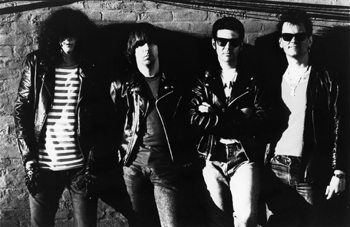![[Metroactive Movies]](/movies/gifs/movies468.gif)
[ Movies Index | Show Times | Silicon Valley | Metroactive Home | Archives ]
Brat Beaters: The Ramones never quite got the big score they wanted between starting in Queens and ending up in the Rock and Roll Hall of Fame.
Beaten Brats
Rock was a cruel mistress for the Ramones, as seen in the documentary 'End of the Century'
By Richard von Busack
MY LACKEY can't jettison Charles' jester! That's the easily remembered acronym for the Three Stooges' lineup: Moe, Larry, Curly, Joe and Curly Joe. But no one's come up with a way to remember the subsidiary Ramones once you're past the trio of Johnny (guitarist John Cummings, conservative control freak); the late Dee Dee (Douglas Colvin, bass player, Fred Flintstone sound-alike, heroin-fancier); and the much-missed Joey (OCD-stricken vocalist Jeffrey Hyman, the poetic, geeky soul of the rough-housing group). The documentary End of the Century introduces Ramones Tommy (producer and drummer), Marky, C.J. and Ritchie, as well as the mysterious Elvis Ramone, credited but apparently off-camera.
The Three Stooges come to mind probably because, like the Stooges, the Ramones were all about the grind of showbiz. They toughed it out, shoulder to the wheel, playing the same piss-bucket nightclubs they always played at, while being loved to pieces by fans in England and Brazil. Fair-weather fans will be dismayed to hear that the Ramones put out 18 records. That means a dozen records after 1980's End of the Century, their recording-studio ordeal at the hands of the cracked music producer Phil Spector. The band was never quite the same after that experience.
Interviews with these fire starters of punk rock indicate that all were saddened by their failure to make the Billboard Top 40. They went from Queens to the Rock and Roll Hall of Fame without a truly delicious big score in between. The mass media went crazy about the Sex Pistols, not the New York band they were imitating. (Touchingly, Johnny Rotten was frightened to meet the Ramones, for fear of getting beaten up by the scary New Yorkers.) Moreover, romantic rivalry between "brothers" Joey and Johnny made the band strictly a business arrangement for about 15 years of the Ramones' 21-year life span. Apparently, some of the tenderer love songs Joey wrote, such as the irreplaceable "Questioningly," were about the heartbreak he never got over.
Co-directors Michael Gramaglia and Jim Fields have rounded up archival photography that looks just the way punk-rock sounds. Most culturally priceless is 8 mm film shot in CBGB's—a Bowery-bum bar, with sawdust and dog shit on the floor, embedded in a panicked mid-1970s New York. The visual quality of these sequences makes them look like a live telecast from Neptune, but these are some of the only moving images of the fabled club in its beginning. The slightly more visually sophisticated Ramones videos of the early years have nailed-in-place cameras, drooping banners on the walls and sunglasses-masked figures: these snippets look like communiqués from a terrorist group.
The Ramones were an underground band that never developed. In the 1970s, they created a coffer of essential punk anthems like "Pinhead," "Beat on the Brat" and "Lobotomy" and steadfastly stuck with their original sound. The Ramones' admirable unchangeablility draws respect from Fields and Gramaglia, but there's a downside: avoiding musical evolution ultimately made this unique and much imitated act about as relevant to changing times as Sha-Na-Na.
[ Silicon Valley | Metroactive Home | Archives ]
![]()

Photograph by George DuBose
End of the Century (Unrated; 120 min.), a documentary by Michael Gramaglia and Jim Fields, opens Friday at Camera 12 in San Jose.
Send a letter to the editor about this story to letters@metronews.com.
From the August 25-31, 2004 issue of Metro, Silicon Valley's Weekly Newspaper.